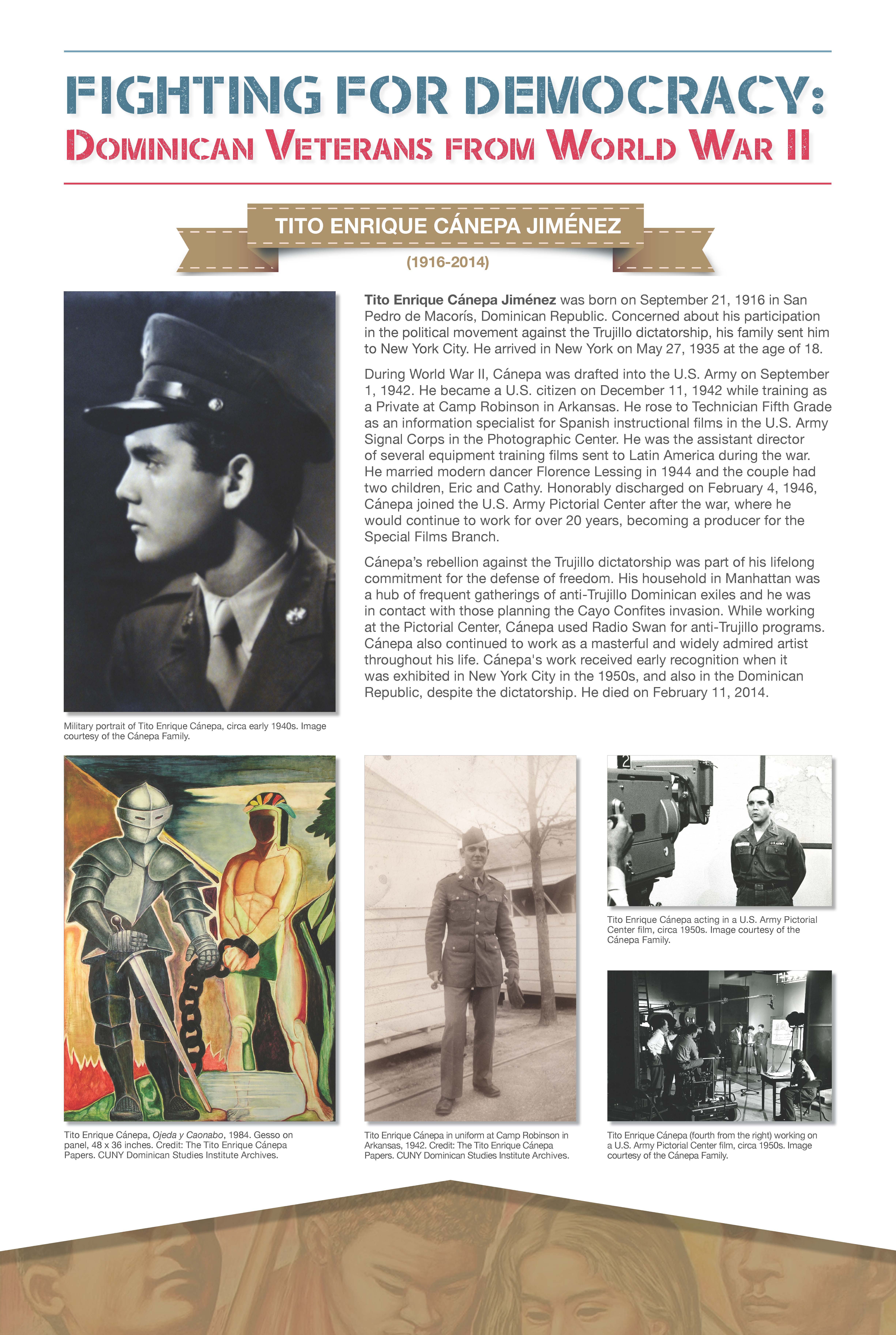Tito Enrique Cánepa Jiménez
Title
Tito Enrique Cánepa Jiménez
Subject
Dominican Immigrants|Dominican Veterans|Dominicans in Politics|Dominicans in the United States|Rafael Leónidas Trujillo|World War II
Creator
CUNY Dominican Studies Institute
Source
The Cánepa Family and the CUNY Dominican Studies Institute Archives
Date
1916-2014
Contributor
Edward De Jesús, Principal Investigator / Curator
Ruth Lizardi, Coordinator / Assistant Curator
Dr. Ramona Hernández, Director, CUNY DSI & Professor of Sociology, The City College of New York
Anthony Stevens-Acevedo, Assistant Director
Idilio Gracia Peña, Chief Archivist
Sarah Aponte, Chief Librarian
Jessy J. Pérez, Archivist
Jhensen Ortiz, Assistant Librarian
Groana G. Meléndez, Photography Editor
Norma Guzmán and Donald Mounts, Researchers
Dr. Tim Williams, Senior Editor
Mariel Acosta, Katie Duarte, Shaday Fermín, and Anthony Stevens-Acevedo, Editors
John P. Bimbiras, Edward De Jesús, Jhensen Ortiz, Jessy J. Pérez, Sophia Monegro and Natalie A. Studt, Biography Text Writers
Isabelia Herrera, Grant Writer
Javier Pichardo, Graphic Artist
Sponsor: CUNY Dominican Studies Institute
Sponsor: Colin Powell School for Civic and Global Leadership at The City College of New York
Sponsor: Latino Americans: 500 Years - National Endowment for the Humanities
Sponsor: American Library Association
Sponsor: New York City Council
Sponsor: Smithsonian Latino Center
Sponsor: Center for Puerto Rican Studies (Centro)
Sponsor: The Documentary Forum - CCNY Center for Film, Journalism, and Interactive Media
Sponsor: Dominican Students Association
Format
24" x 36" panel
Language
English
Biographical Text
Tito Enrique Cánepa Jiménez was born on September 21, 1916 in San Pedro de Macorís, Dominican republic. Concerned about his participation in the political movement against the Trujillo dictatorship, his family sent him to New York City. He arrived in New York on May 27, 1935 at the age of 18.
During World War II, Cánepa was drafted into the U.S. Army on September 1, 1942. He became a U.S. citizen on December 11, 1942 while training as a Private at Camp Robinson in Arkansas. He rose to Technician Fifth Grade as an information specialist for Spanish instructional films in the U.S. Army Signal Corps in the Photo graphic Center. He was the assistant director of several equipment training films sent to Latin America during the war. he married modern dancer Florence Lessing in 1944 and the couple had two children, Eric and Cathy. Honorably discharged on February 4, 1946, Cánepa joined the U.S. Army Pictorial Center after the war, where he would continue to work for over 20 years, becoming a producer for the Special Films Branch.
Cánepa's rebellion against the Trujillo dictatorship was part of his lifelong commitment for the defense of freedom. His household in Manhattan was a hub of frequent gatherings of anti-Trujillo Dominican exiles and he was in contact with those planning the Cayo Confites invasion. While working at the Pictorial Center, Cánepa used Radio Swan for anti-Trujillo programs. Cánepa also continued to work as a masterful and widely admired artist throughout his life. Cánepa's work received early recognition when it was exhibited in New York City in the 1950s, and also in the Dominican republic, despite the dictatorship. He died on February 11, 2014.
During World War II, Cánepa was drafted into the U.S. Army on September 1, 1942. He became a U.S. citizen on December 11, 1942 while training as a Private at Camp Robinson in Arkansas. He rose to Technician Fifth Grade as an information specialist for Spanish instructional films in the U.S. Army Signal Corps in the Photo graphic Center. He was the assistant director of several equipment training films sent to Latin America during the war. he married modern dancer Florence Lessing in 1944 and the couple had two children, Eric and Cathy. Honorably discharged on February 4, 1946, Cánepa joined the U.S. Army Pictorial Center after the war, where he would continue to work for over 20 years, becoming a producer for the Special Films Branch.
Cánepa's rebellion against the Trujillo dictatorship was part of his lifelong commitment for the defense of freedom. His household in Manhattan was a hub of frequent gatherings of anti-Trujillo Dominican exiles and he was in contact with those planning the Cayo Confites invasion. While working at the Pictorial Center, Cánepa used Radio Swan for anti-Trujillo programs. Cánepa also continued to work as a masterful and widely admired artist throughout his life. Cánepa's work received early recognition when it was exhibited in New York City in the 1950s, and also in the Dominican republic, despite the dictatorship. He died on February 11, 2014.
Citation
CUNY Dominican Studies Institute, “Tito Enrique Cánepa Jiménez,” Fighting for Democracy: Dominican Veterans from World War II, accessed November 21, 2024, https://dsi.ccnydigitalscholarship.org/dominican-veterans-wwii/items/show/43.

